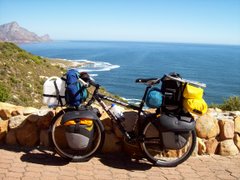








Yes, I'm in Nazca Peru, famous for the ancient lines in the desert. But first I had to get to Nazca from inland where I posted my previous report, and that is what this story is about. From the town of Abancay I first dropped down to 2000 m before gradually climbing up the Apurimac river gorge. Along the way I camped in some nice places, and I also stayed in very basic accommodation reminiscent of Ethiopia or India. Then I climbed steeply to a long plateau which varied in altitude from about 4200 metres to over 4500 m. There were some interesting geological features, as well as salt crystals formed by the mineral water dripping down the roadside embankment. In the late afternoon somewhere along the plateau I found Pampamarca village, where I spent the freezing night in an unhygienic mud-hut room at 4200 m. The following morning I was not at my best, I felt sluggish, and not in the mood for uphills. In the past couple of months I'd spent a lot of time at high altitude, so I was not too concerned about my health. However, immediately after leaving the village the road climbed again, much to my discomfort. Soon after checking my GPS at 4560 metres it hit me - ALTITUDE SICKNESS. The dull headache I'd had all morning turned nasty, I felt nauseous, weak, and shaky. The day turned into a miserable, drawn-out effort. For the next 50 km I somehow managed to drag myself along that desolate undulating plateau. The herds of llama along the way with their comical faces no longer interested me, and when scarce wild Vicuna's crossed my path just metres ahead I couldn´t even be bothered to take a picture. Fortunately, somewhere on the subsequent 45 km downhill to Puquio I miraculously recovered, and as a measure of comfort I booked into a nice room in the town. I walked around the bustling streets and bought all sorts of goodies at the markets for my dinner. Later, after a long hot shower I was sitting between clean sheets watching TV - and try as I might, I couldn't re-create the misery of the day in my mind, I was just too far removed! The following day I again climbed to a high plateau, where I camped for the night at over 4000 metres. Except for the cold, I felt strong and healthy (I had to keep my drinking water in the tent with me to prevent it from freezing). The following morning while I was packing my bike 2 Swiss cyclists arrived from the opposite direction, having taken 3 days to cycle the 100 km from Nazca. It took me only 3 and a half hours to reach Nazca (including taking lots of pic's and repairing a puncture). After a gradual descent along the plateau I suddenly dropped off the edge of the World! I descended the 3500 metres from desert mountain to coastal desert in a hair-raising winding dive of about 60 km. So, now I get back to Nazca, famous for it's ancient lines in the desert. I probably won't be seeing those lines, as I draw the line on extravagance before taking an airplane flight to see lines on the ground. When I leave this town I'll cycle past a viewing tower, but apparently even from there one has to use your imagination in order to make out the figures represented by the lines. On the bright side, I haven't been down at this altitude since Eastern Bolivia, and it feels as though I'm breathing pure Oxygen and bouncing around on springs! I'm not yet at the Pacific Ocean, as the road now runs parallel to the coast for a while, but I'll get there before my next report. Daily distances cycled since Abancay have been: Santa Rosa 72 km; Mt Stream Camp 85 km; Pampamarca 51 km; Puquio 108 km; Pampa Galeras Nat Pk 64 km; and Nazca 98 km. The total distance cycled in South America so far is 13 882 km, and the total distance I've cycled on this trip is 80 369 km.






























